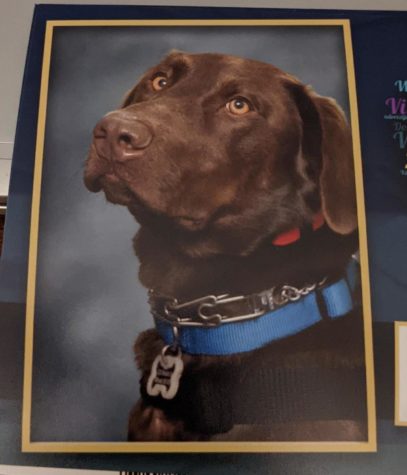An Unofficial Mascot of Pacific
December 16, 2021
If you have not yet met Hank, you are missing out. In the event you do know about Hank the therapy dog, you are in for a treat.
Hank is a 2 year old chocolate Labrador and member of Dr. Quinn Flexsenhar (Alternative Program) and Mrs. Amy Flexsenhar’s (Zitzman Elementary) family.
“A friend of a friend had puppies and we went to visit and picked him up that day. We’ve had him since he was 8 weeks old,” Q. Flexsenhar said.
Through circumstance, the Flexsenhars realized Hank’s propensity to become a therapy dog.
“We adopted Hank in October 2019. He broke his leg in December 2019 and then COVID happened in March 2020,” A. Flexsenhar said. “We were with Hank constantly during this time and he seemed to love being around people. When school started back up he was lonely at home, and that was when we had the idea to get him certified as a therapy dog to come to school. So really, we didn’t need a therapy dog, he just needed to be a therapy dog.”
This began Hank’s journey to becoming a certified therapy dog. It involved a lengthy training program. Hank first had to pass a disposition test before he could even begin training. This helps the trainer determine whether his personality would be good for a dog in close contact with lots of people.
He had 6 full weeks of training before the first certification test. He has an additional six weeks over the next six months to ensure that he is adapting to his role as a therapy dog as well as any refreshers he might need. His training consists of learning the following commands: Sit, Come, Down (lie down), Climb (jump onto a specific place). He learns these commands with an implied Stay – meaning that he stays in the command until he is released by his handler. During his training, he practices these commands in many different environments and around other people and animals.
“His training also prepares him to be touched and petted a lot by all different kinds of people – small children, adults, people in wheelchairs, etc,” A. Flexsenhar said. “The training ultimately wants to ensure that he is comfortable in any environment and enjoys the company of humans – which he loves!”
With two educators in the family, transitioning Hank to a school therapy dog was a natural fit.
“It has everything to do with him making students feel more comfortable and happier at school,” Q. Flexsenhar said. “Therapy dogs help people calm down and relax. They can help people feel more comfortable and they can also show children how to slow down, be gentle, and help handle their emotions.”
Having a therapy dog in school has been beneficial for students.
“I have never seen anyone walk away from him without a huge smile on their face,” Q. Flexsenhar said.
“It’s just comforting seeing him around school,” senior Aubrey Harris said. “Every time I see him I yell ‘Hank’! It’s just so nice to see him.”
“It’s a stress reliever to see a dog in school,” senior Michael Aehle said. “It instantly makes me feel better.”
“He goes everywhere with us that dogs are allowed,” A. Flexsenhar said. “Because he is certified as a therapy dog, not a service animal, we have to follow all rules pertaining to pets just like everyone else. The difference between a service animal and a therapy animal is in their training and how they are used. Service animals go through months and months of training specifically to work for a person with a disability. A therapy animal goes through training with their handler (usually their owner) that conditions them to be around all different kinds of people and interact with them. The therapy animal is just a regular pet at home, but can go on visits with their handler to interact with people, calm them down, regulate emotions, or just make people smile.”
There will soon be an addition to the MVR3 therapy dog family.
“We love having Hank as a therapy dog so much that we’re actually adopting another puppy that we also plan on training,” Q. Flexsenhar said.


